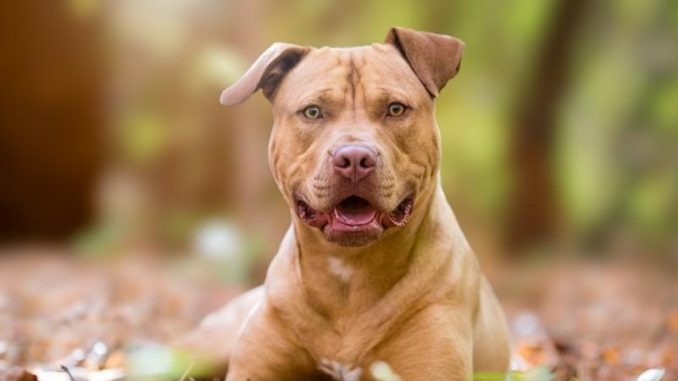
The American pit bull terrier, commonly referred to as a pit bull or pitbull, is one of the most common breeds in the United States and is known for its loyalty, friendliness, and determination to please humans.
American pit bull terriers are great with children, but not with other dogs. Pit bulls shouldn’t be used as guard dogs and shouldn’t live in households with other pets.
Growing from 30–60 pounds and 17–21 inches tall puts American pit bull terriers in the category of medium-sized dogs. This breed also lives longer than most breeds, with a lifespan of 12–16 years.
The American pit bull terrier breed is recognized by the United Kennel Club (UKC), but not by the American Kennel Club (AKC).
The AKC recognizes the American Staffordshire Terrier, which is a strain of the American pit bull terrier breed.
TABLE OF CONTENTS
- American Pit Bull Terrier Quick Summary
- American Pit Bull Terrier Appearance
- American Pit Bull Terrier Origins
- American Pit Bull Terrier Temperament
- American Pit Bull Terrier Laws & Bans
- Taking Care of an American Pit Bull Terrier
- How to Train an American Pit Bull Terrier
- American Pit Bull Terrier Price
- Should You Get an American Pit Bull Terrier?
- FAQs
American Pit Bull Terrier Quick Summary
| Breed Type | Mixes and more |
| Other Names | Pit bull, pit bull terrier |
| Breed Strains | Colby terrier, Old Family Red Nose, American Staffordshire terrier |
| Suitable For | Families with children, police work, therapy, performance sports |
| Lifespan | Families with children, police work, therapy, performance sports |
| Height | 17–20 inches (female), 18–21 inches (male) |
| Weight | 30–50 pounds (female), 35–60 pounds (male) |
| Color Variations | Brown, black, white, red-brown, spotted, tuxedo |
| Coat Type | Smooth, stiff, glossy |
| Shedding | Low |
| Temperament | Playful, Loving, Affectionate, Intelligent, And Sociable |
| Grooming Needs | Weekly brushing, monthly nail clipping, bathing as needed |
| Exercise Needs | One hour minimum per day |
| Daily Diet | ½ cup of food for every 10 pounds of weight, twice a day |
| Price | $800–$2,500 |
American Pit Bull Terrier Appearance
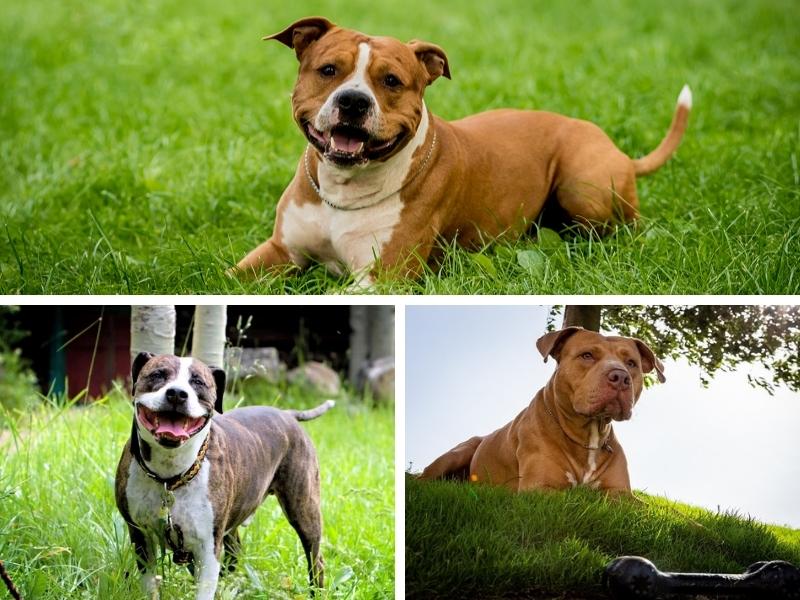
From Adobe Stock
American pit bull terriers are short, muscular dogs that are slightly longer than they are tall. They have wide heads, thick bodies, pointed ears, and tails that are thick at the base and taper to a point.
This dog’s short, glossy coat comes in all color patterns and variations.
Height and Weight
American pit bull terrier females and males differ in height and weight, but only by a few inches and pounds.
A female grows 17–20 inches tall and weighs 30–50 pounds. Males grow 18–20 inches tall and weigh 35–60 pounds.
American pit bull terriers grow to their full height at 12 months, but continue to fluctuate in weight depending on their diets and exercise routines.
Breeding lines can also affect size and weight. Some show dogs are bred to be larger than standard American pit bull terriers. Paw size and breeding history can help to determine a dog’s future size.
Coat
American pit bull terriers have a smooth, glossy coat that stays short and stiff. The coat can come in many different colors, patterns, and variations, including the rare brindle pit bull.
American pit bull terriers are not hypoallergenic, but they have mid to low shedding and don’t collect debris in their coats easily.
Breed Strains
The color and appearance of an American pit bull terrier depends on its breeding history and distinct breed strains that are recognized by breeders and kennel clubs.
- Colby pit bull: White and black coated with black noses
- Red nose pit bull (Old family red nose): Brown and red coloring with red or amber eyes, a red nose, and red toenails
- American Staffordshire terrier: Bigger than average pit bulls and recognized by the AKC
American Staffordshire terriers come from American pit bull terrier breeding, but the American Staffordshire terrier was bred with different intentions, like more muscular and taller bodies due to dog show standards, and appears different from the standard American pit bull terrier.
American Pit Bull Terrier Origins
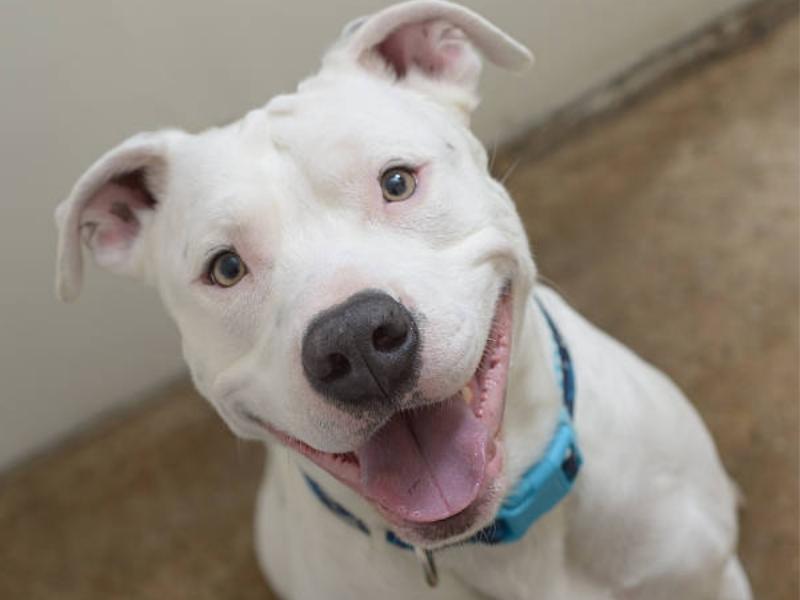
From Adobe Stock
American pit bull terriers come from a long history of breeding that began in the British Isles.
Old English bulldogs and old English terriers were bred together for bloodsports like bear-baiting, bull-baiting, and dogfighting.
In the 1800s, American pit bull terriers came to the United States with Irish, British, and Scottish immigrants.
Dog breeding in America caused American pit bull terriers to have the size and temperament that shows today.
In 1898, the UKC recognized the breed.
American pit bull terriers were accepted into the AKC stud book, but the organization renamed the breed.
Because “pit bull” relates to dog fighting, the AKC named the breed after the UK county of Staffordshire, where the breed originated from.
The AKC recognized American pit bull terriers in 1936 under the name “American Staffordshire terrier.”
American Pit Bull Terrier Temperament
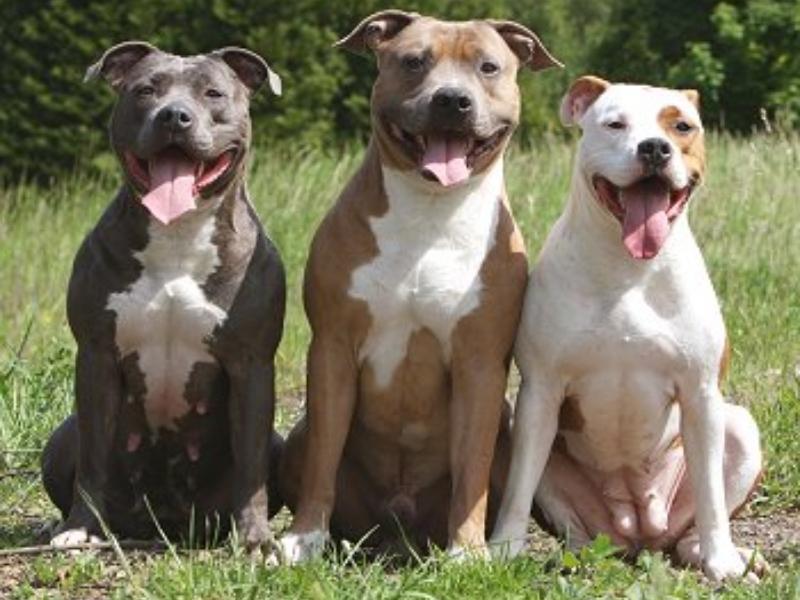
From Adobe Stock
American pit bull terriers are loyal and friendly dogs. They’re great with kids and make wonderful family dogs. This breed shouldn’t be used as a guard dog because it’s openly friendly with strangers.
American pit bull terriers are aggressive towards other dog breeds and have a high prey drive.
Small animals like birds and rabbits shouldn’t be kept with the American pit bull terrier, and it needs proper socialization and training to be around other dogs.
American Pit Bull Terrier Laws & Bans
Multiple countries, territories, and cities have enacted breed-specific laws that prevent ownership, breeding, and importing of “pit bull-type dogs” because of a scientific study by Vet Med Today that accused certain dog breeds of being more likely to bite humans and cause bite-related fatalities.
This study was disputed and peer-review studies found that the breed does not determine aggression or likelihood of attacks.
Many laws have already been repealed, but owners should check local laws before traveling with, breeding, or adopting American pit bull terriers.
Taking Care of an American Pit Bull Terrier
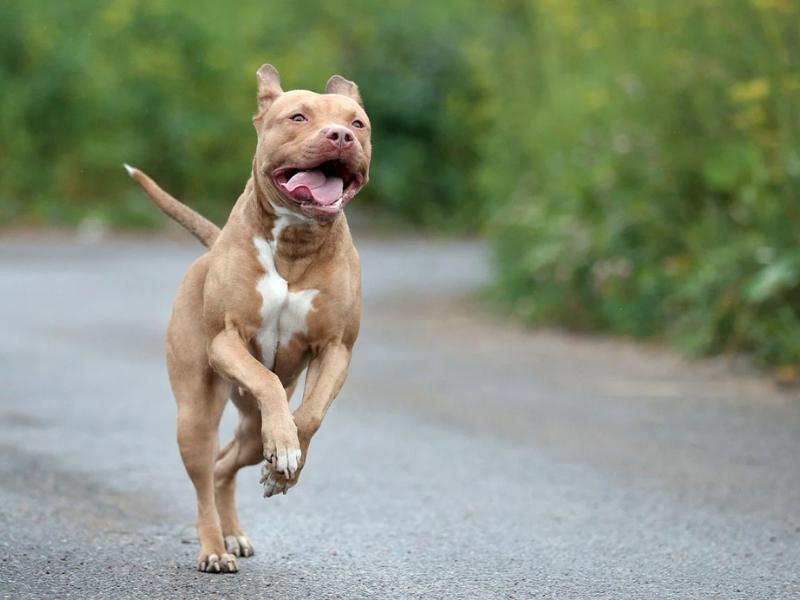
From Adobe Stock
American pit bull terriers are easy to train and have few grooming needs, which makes them easy to care for. However, this breed has genetic health conditions that require responsibility and maintenance.
Food Needs
American pit bull terriers don’t have specific dietary requirements. They should be given high-quality food that is approved by veterinarians.
Puppies, adults, and senior dogs should be given age-specific food.
American pit bull terriers can be given a half cup of food for every 10 pounds of body weight twice a day.
This amount shouldn’t exceed five cups per meal as over-feeding leads to obesity and health problems.
Grooming Needs
American pit bull terriers have smooth, short coats that don’t require regular trimming or bathing.
Short coats should be brushed once a week to encourage healthy oil production and remove dead skin and foreign objects from the hair.
All dogs should have their nails trimmed every three or four weeks, and this breed only needs to be bathed if they’re starting to smell.
Exercise Needs
American pit bull terriers aren’t overly energetic, but they’re muscular and excel at training exercises and sports like weight pulling and other performance events.
This breed can be left alone during the day, but it should have at least an hour of exercise each day.
American pit bull terriers make good house dogs, but may develop digging or chewing behaviors without healthy outlets.
Larger dogs can hold their bladders for longer periods, but American pit bull terriers should be let out and walked at least twice a day to prevent kidney or bowel problems.
Mental Needs
American pit bull terriers don’t need a lot of activities to stimulate them during the day, but they are intelligent and eager to learn. Training and puzzles help this breed avoid boredom and bad behavior.
This breed has a high prey drive so balls or interactive chew toys help the dog to express this behavior in healthy ways.
Common Health Concerns
As with many purebred dogs, the American pit bull terrier is prone to certain health issues such as:
- Congenital Cardiac Disease: an irregularly formed heart or blood vessels
- Degenerative Myelopathy: degeneration of the spinal cord leading to paralysis
- Demodectic Mange: mites that can cause hair loss, itching, and sores.
- Elbow Dysplasia: multiple genetic joint deformities that can cause pain and bone damage
- Hip Dysplasia: abnormally formed hip joints that lead to pain or frequent dislocation
- Patella Luxation: frequency of the kneecap popping out of place
- Thyroid issues: an improperly functioning thyroid
- Canine Parvovirus: a virus that can cause vomiting, diarrhea, and digestive issues and can lead to death
Detailed breed health statistics can help owners understand the health risks associated with each breed.
Regular veterinary testing and bloodline research helps to prevent and treat these health issues. Yearly parvovirus vaccinations are essential for American pit bull terriers.
Puppies should also receive all available vaccinations before they interact with other dogs or animals.
How to Train an American Pit Bull Terrier
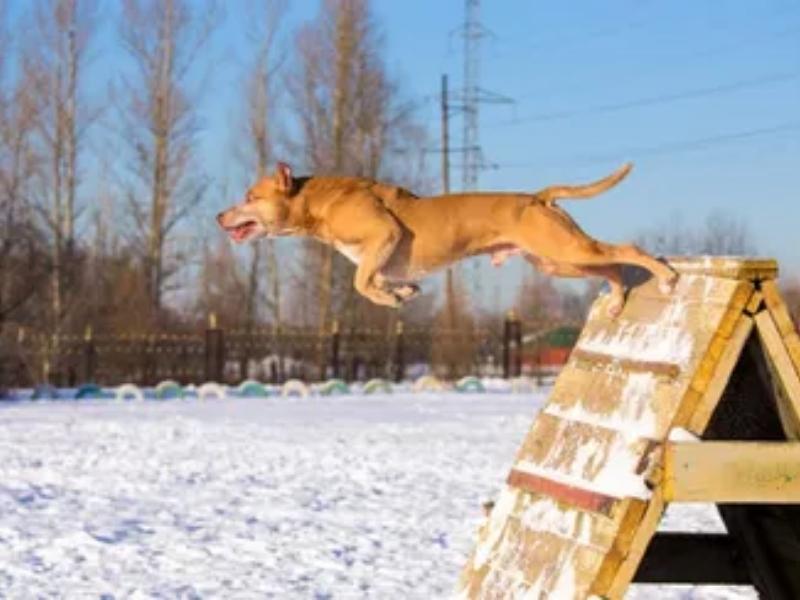
From Adobe Stock
American pit bull terriers are obedient dogs that love to please their owners. This breed is easy to train and does well with mental challenges.
Socializing puppies with other dogs is essential to prevent dog aggression. Watch carefully during dog interactions to reward positive behavior, or break up negative behavior.
The American pit bull terrier mentally develops for its first three or four years, so aggressive behaviors can develop at any time. There are plenty of puppy training tips that will help your pit bull pick up good behavior during its formative years.
Aggressive reactions are dangerous for owners to break up, but break sticks help to avoid owner injuries and breach the bite hold of American pit bull terriers.
These tools are useful to stop fights between American pit bull terriers and other dogs. Detailed break stick understanding is important for multi-dog households.
American Pit Bull Terrier Price
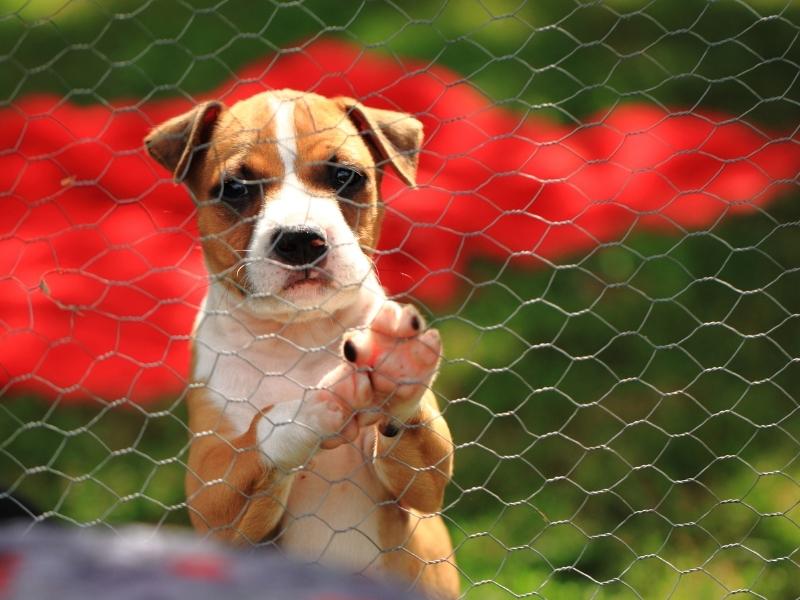
From Adobe Stock
American pit bull terriers are expensive dogs if they’re from champion bloodlines, but puppies without registration, adults, and mixed breeds are cheaper.
This breed is also common in shelters, so adoption is accessible and affordable.
How Much is an American Pit Bull Terrier?
American pit bull terriers cost $800–$2,500. Age, bloodline, and color can affect pricing.
Adopting and rescuing are great alternatives for potential owners on a budget.
American pit bull terrier breeders include:
Adoption and rescues include:
How Much Does it Cost to Raise an American Pit Bull Terrier?
American pit bull terriers have infrequent grooming needs that lower recurring costs. However, this breed has a high risk of serious health conditions, like hip dysplasia and Parvovirus, that are costly to treat and deadly if untreated.
Screening and vaccinations are necessary to prevent serious diseases.
Raising an American pit bull terrier costs $950–$2,200 per year or $80–$170 monthly.
Puppies need vaccinations, health checks, and, potentially neutering or spaying. Initial costs for an American pit bull terrier puppy range from $300–$700.
Estimated Costs
| Grooming | $30–$100 as needed |
| Nail Trimming | $10–$20 monthly |
| High-Quality Food | $50–$100 per month |
| Training | $30–$80 per class |
| Health Screening | $10–$50 per test |
| Veterinary Checkups | $100–$300 annually |
| Puppy Vaccinations | $20–$100 |
| Parvovirus vaccine | $20–$50 annually |
| Heartworm Prevention | $20–$50 monthly |
Many animal shelters and non-profit organizations provide vaccinations, health screenings, neutering, spaying, and medication at a cheaper price.
Should You Get an American Pit Bull Terrier?
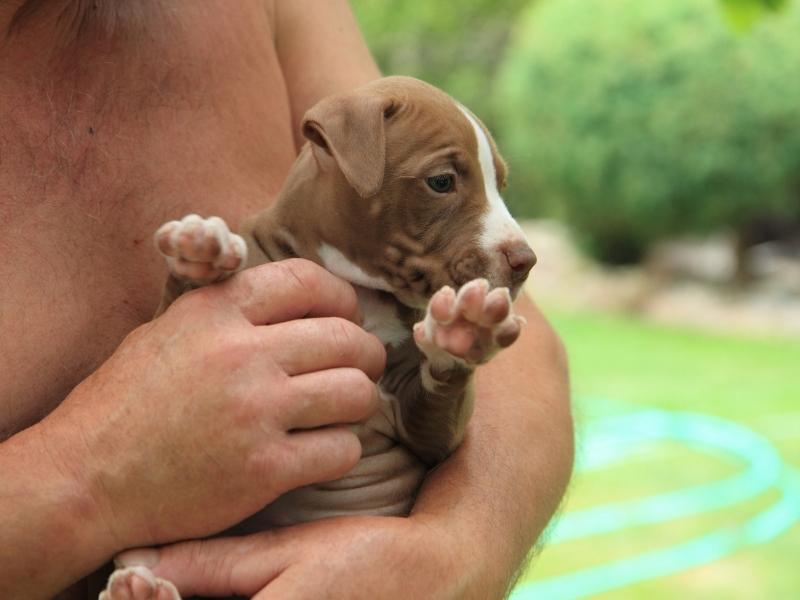
From Adobe Stock
American pit bull terriers have lived alongside people for generations and their human-loving nature makes them a loyal addition to any family.
Children and adults can equally enjoy playing with and training this breed.
American pit bull terriers aren’t perfect for every environment, however, due to their prey-hunting nature and aggressive behavior towards other dogs.
American Pit Bull Terriers are Suitable for:
The American pit bull terrier is best for owners or families that have moderately active lifestyles and a decent amount of dog-owning experience. American pit bull terriers are suitable for:
- Families with children
- Police work
- Dog therapy
- Dog performance competitions.
- Owners that want a loyal and obedient pet
As hard-working and loving dogs, American pit bull terriers need owners who will take the time to firmly train and care for the needs of their dog.
American Pit Bull Terriers are NOT Suitable for:
With moderate energy levels, American pit bull terriers are primarily indoor dogs and are affectionate with their owners and families.
However, as a prey-driven breed with aggression towards other dogs, the American pit bull terrier is not suitable for:
- Houses with more than one dog
- Houses with other pets
- Owners will low activity or low-energy
- Beginner/inexperienced dog owners
- Owners who don’t practice strict obedience when training
American pit bull terriers are adaptable and can be kept in different situations, but owners must always consider the safety of other pets and themselves when taking this breed into new settings.
FAQs
- Are American Pit Bull Terriers Hard to Train?
- Why Are American Pit Bull Terriers so Mouthy?
- Why Are American Pit Bull Terriers so Whiny?
- Why do American Pit Bull Terriers Cuddle so Much?
- Why Are People Scared of the American Pit Bull Terrier?
- What Is the Difference Between an American Pit Bull Terrier and an American Staffordshire Terrier?
- How Was the American Pit Bull Terrier Originally Bred?
- How Tall Are American Pit Bull Terriers?
- How Much Does the Average American Pit Bull Terrier Weigh?
- Why Is the American Pit Bull Terrier Banned in the UK?
- How Long Can an American Pit Bull Terrier Live?
- What Was the American Pit Bull Terrier Bred for?
- Is an American Pit Bull Terrier the Same as a Pitbull?
- Is an American Pit Bull Terrier a Good Family Dog?
- Are American Pit Bull Terriers Aggressive?
- How Much Does an American Pit Bull Terrier Cost?

Be the first to comment